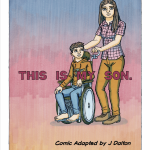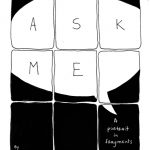Artist’s Statement
This narrative comic focuses on a child’s experience of going to the hospital and having to undergo anesthesia. I aimed to capture the child’s perception of feeling as if everyone is against them, when in reality, it is for their benefit. The child is frightened by ,machines and hospital equipment, and wants to free herself from these unpleasant experienced. Each time she undergoes any procedure, anesthesia is necessary, and I want to illustrate how traumatic the experience is not only for the child but also for the hospital staff and adults involved.
Artist’s Statement
Hello!
This comic is about what it might feel like to navigate the medical system as a child with complex behaviours or needs. For both the child and the caregivers, it can be anything from frightening to tedious to frustrating to traumatic. I wanted to try and capture that experience through a series of comparisons. If you’ve experienced these things, I hope you feel seen and heard. If you haven’t, I hope you gain an understanding of how they can feel! Thank you for reading!
Eve
“This is My Son”, Jonathan Dalton
Artist’s Statement
This comic was based as closely as possible on the account of “Thomas'” mother. She spoke passionately about her and her son’s situation, with a mix of specific examples and the philosophy that those anecdotes have developed in her. I took my job as being merely the messenger, reformatting her words into a tight narrative essay in comics form. Since I was unable to check back with her for feedback during this process, I can only attest to this being my best effort to interpret what she said.
One of the things about comics is it’s a medium that can make a strong, personal-feeling, emotional connection with the audience. I definitely wanted to use the full comics toolbox to make this family relatable and empathetic to anyone who might read it. “Thomas” reminds me of kids that I’ve met in real life, and while this particular child isn’t one I’m ever likely to know in person, I want him to be knowable to the reader, who will also never meet him. You will meet kids like him. It helps to have a starting point.
– JD
“Appointment Day”, Natasha Gauthier
Artist’s Statement
I was drawn to this project because my mom spent a large part of her childhood in the BC Children’s Hospital, and I felt called to help turn up the volume on the stories of children and families that are often not heard. My comic is an abstract exploration of the alienation and misunderstandings that came across in caregivers’ stories of navigating a lifetime of appointments with specialists and other medical professionals, and also the judgement and opinions of strangers whenever going out in public. What really stood out was how these kids just want to be kids, to have fun and explore and go on adventures and to make new friends in a world that is not always so friendly.
Natasha Gauthier is a white and Indigenous hybrid writer and visual artist who lives on the unceded/stolen land of the Qayqayt First Nation and Coast Salish peoples, commonly known as “New Westminster, BC.” She is the Prose Editor for PRISM International and an MFA candidate at UBC. She’s a cool mom, a punkish aunty, and a lover of all things strange and unusual.
Artist’s Statement
Hola, soy Logaine. I’m a Peruvian writer and artist. I’ve been living, learning and growing as an uninvited guest in the ancestral lands of the Coast Salish peoples- Musqueam, Squamish, Tsleil-Waututh and Semiahmoo- for six years now. I feel truly privileged to be here. Mucho gusto.
As a mother, I was deeply touched by this story of love and resilience. As an immigrant, I can relate to the frustration of not being fully seen and having to navigate situations with a lack of clarity, empathy, and information.
In times when fragmented points of view pose the threat of dehumanisation, giving voice to the least represented becomes even more important. I hope these works spark many conversations, even if, to see each other, we must start asking difficult questions.
Artist’s Statement
The lens which we understand life comes from our own experiences, and the lens which I wear is of a late diagnosed autistic adult who has been failed and traumatized by the medical system multiple times.
As I read through the interview, I felt depressed. Having fallen through the gaps in the healthcare system my entire life, I understood the despair. I resonated with the lack of agency, the fear, the trauma and the betrayal. How could a system meant to help people be so detrimental?
But I also felt conflicted. Here I was, in this unique position as an autistic with lived experience, but who am I to define another person’s experience? After all, I also remember when language was a luxury I did not have.
Before I could communicate for myself, others defined my life for me. When I was first diagnosed with speech and language delay, my dad cried. My parents were told what I was capable of and what to expect. My mom fought for my right to an education as my kindergarten teacher didn’t want me in her class. People assumed I didn’t know what was going on. When I was 7, I was called stupid in front of the class by my teacher. I couldn’t respond back, even though I wanted to say, “Only stupid people call other people stupid”.
Today, I have a voice, and I don’t take that for granted. I am also cognizant there are others who don’t, and depend on others to help them. 3 different situations, 1 comic, “BOX” is the story about being neglected by the healthcare system.
Artist’s Statement
I first met S on a piece of paper. I named her ‘Sammy’ in the comic but I will never know her real name. And that’s okay. Advocacy isn’t just about the person in front of you; it’s about helping to make a better future for the people who come afterwards.
I’ve had my own experienced navigating the healthcare system as an autistic person so I was really excited for this project and to tell S’s story. I wanted to be able to make changes for kids like S and get people to reconsider how disabled people access healthcare.
I think one of the greatest aspects of storytelling through comics is that you can show and tell people what happened. You get the opportunity to be a reporter; and the pictures you draw can help convey the very real emotion of the moment. Comics can make you feel like you were there; like a witness.
Please be S’s witness.
Sincerely,
Elsbeth Dodman
“Treading Water”, Katherine Chupik-Hall
Artist’s Statement
“Treading Water” has been my attempt at an exploration of disability as something fragmented and complex, such as a reflection in a pool. Water is “August’s” (all names have been changed within this narrative in order to protect the privacy of the family referrened) greatest grounding force, an integral and soothing part of his routine. Yet when seas become rough water has the potential to harm and displace. As well as “August’s” way of navigating the world, I wanted to highlight the mother’s experience within this narrative, as an outside force riding the waves. There exists a large communication barrier between “August” and his mother, and yet they are both attempting to bridge this divide with the resources they are allotted. Ultimately, the way to work towards functional communication is through the medical system, a nuanced topic in itself. “Treading Water” does not have a clear resolution, a point where every difficult and nebulous factor is given a too-simple solution. Rather, it is about care: from a child, from medical professionals and from two parents. It is a story about assisting those you love even when you cannot fix the more painful aspects of their life.







